
Cómo Helium está transformando la conectividad con DePIN en Solana: un análisis basado en datos
Aumento del 200% en el volumen de créditos de datos: de 67.500 a 206.000 dólares en sólo seis meses
- Publicado:
- Editado:
Las redes descentralizadas de infraestructuras físicas (DePIN) están revolucionando la forma de construir y acceder a la conectividad. Entre los diversos proyectos DePIN, Helium destaca como pionero, especialmente por su transición a la blockchain Solana en abril de 2023. La migración de Helium desde su blockchain original Layer-1 se produjo tras una abrumadora votación del 81% de aprobación de la comunidad (HIP-70) en septiembre de 2022. Este cambio estratégico permitió a Helium escalar de manera eficiente, centrándose en las capacidades básicas de la red en lugar de gestionar una amplia infraestructura de blockchain.
Abhay Kumar, CEO de la Fundación Helium, explica claramente el razonamiento detrás de esta transición durante su entrevista con SolanaFloor:
“Es porque no quería construir todas las otras cosas que necesitas en un L1. No quería construir los mercados de capitales, mercados de préstamos, integraciones de billetera, integraciones de nodo, y todos estos sistemas auxiliares. El uso de Solana es mucho más sencillo para un proyecto como el nuestro, lo que nos permite concentrarnos en nuestra principal fortaleza—que es construir una red inalámbrica y permitir este tipo de economía.
Solana.
Al aprovechar Solana, Helium escaló rápidamente sus operaciones, convirtiéndose en la mayor red LoRaWAN descentralizada a nivel mundial, con más de 700.000 usuarios en Estados Unidos.
El modelo de token unificado de Helium: $HNT en el centro (abril de 2025)
A partir de abril de 2025, la Red Helium ha realizado la transición a un modelo de token unificado centrado en $HNT (Helium Network Token). Este cambio, implementado a través de la Propuesta de Mejora Helium 138 (HIP 138), cesó las emisiones de los tokens $IOT y $MOBILE en enero de 2025.
¿Qué ha cambiado?
-
Recompensas unificadas: Todos los operadores de hotspots, ya proporcionen cobertura LoRaWAN (IoT) o 5G, ahora reciben recompensas exclusivamente en $HNT.
- .
-
Gobernanza simplificada: $HNT sirve como token único para la gobernanza y la utilidad de la red, lo que agiliza el ecosistema.
Entendiendo los créditos de datos: Alimentando la red Helium
Los Créditos de Datos (DCs) son cruciales para la funcionalidad de la red Helium. Estos tokens no comerciables, con un valor fijo de 0,00001 $ cada uno, se utilizan exclusivamente para pagar la transferencia de datos y los servicios de red, como la conectividad IoT y 5G. Los usuarios acuñan DCs quemando tokens $HNT mediante el mecanismo Helium Burn and Mint Equilibrium (HBME) en Solana.
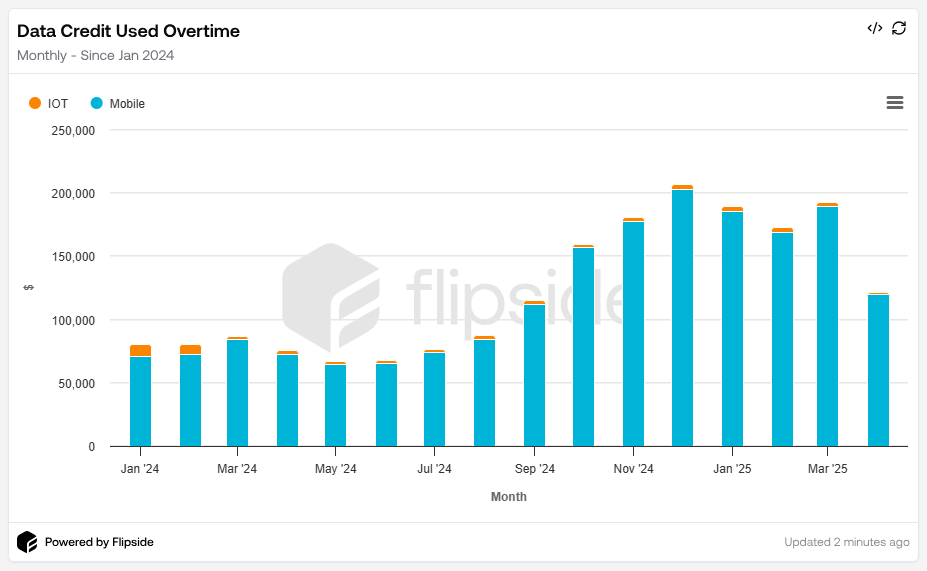 Según Datos de Flipside, el volumen de DC ha aumentado significativamente. El volumen mensual de DC se disparó de aproximadamente 67.500 $ en junio de 2024 a más de 206.000 $ en diciembre de 2024, lo que supone un asombroso crecimiento del 200%. Cabe destacar que la mayor parte del volumen de CC ha procedido sistemáticamente de Mobile, eclipsando a IoT, cuya cuota fluctuó modestamente entre el 1,5% y el 11,6%.
Según Datos de Flipside, el volumen de DC ha aumentado significativamente. El volumen mensual de DC se disparó de aproximadamente 67.500 $ en junio de 2024 a más de 206.000 $ en diciembre de 2024, lo que supone un asombroso crecimiento del 200%. Cabe destacar que la mayor parte del volumen de CC ha procedido sistemáticamente de Mobile, eclipsando a IoT, cuya cuota fluctuó modestamente entre el 1,5% y el 11,6%.
Cambios en el uso de la red: Las operadoras de descarga móvil ganan terreno
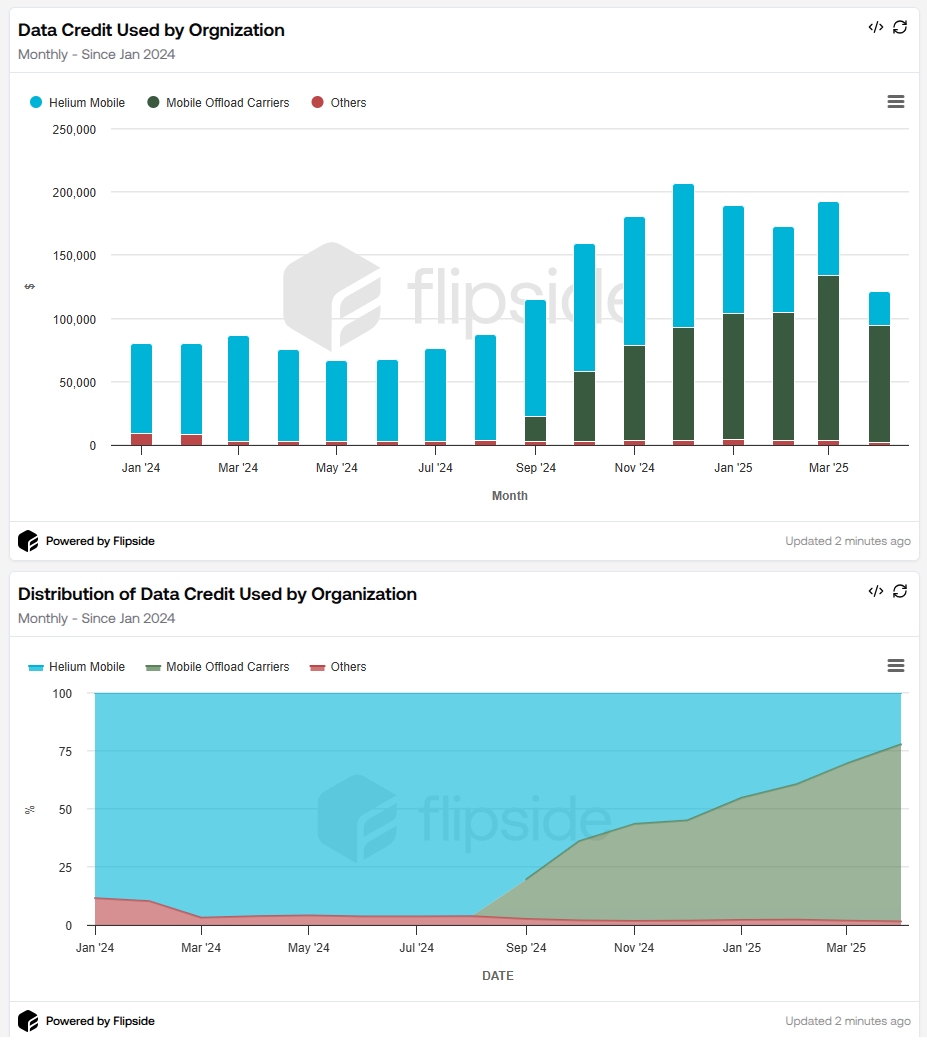 Inicialmente, Helium Mobile dominaba el volumen de CC. Sin embargo, este panorama comenzó a cambiar en septiembre de 2024 por Mobile Offload Carriers. En marzo de 2025, los transportistas de descarga representaban más del 67% del volumen total de CC.
Inicialmente, Helium Mobile dominaba el volumen de CC. Sin embargo, este panorama comenzó a cambiar en septiembre de 2024 por Mobile Offload Carriers. En marzo de 2025, los transportistas de descarga representaban más del 67% del volumen total de CC.
.
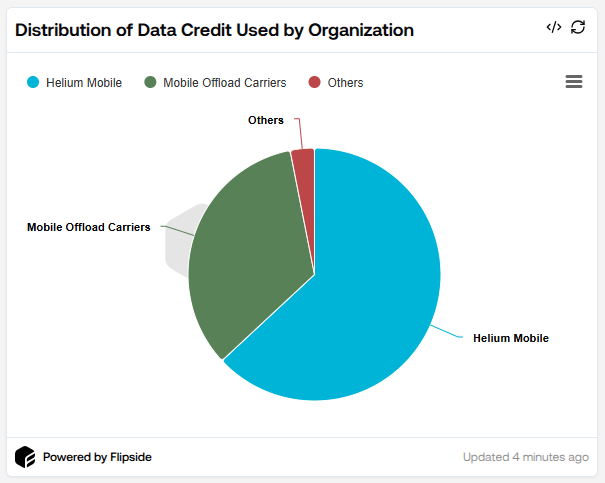 En general, a partir de enero de 2024, Helium Mobile sigue teniendo la mayoría, representando el 63% del volumen de DC, mientras que Mobile Offload Carriers subió rápidamente para capturar el 33,8%.
En general, a partir de enero de 2024, Helium Mobile sigue teniendo la mayoría, representando el 63% del volumen de DC, mientras que Mobile Offload Carriers subió rápidamente para capturar el 33,8%.
Tendencias en la transmisión de datos: Un panorama mixto
 El examen de las tendencias de transferencia de datos pone aún más de relieve el importante crecimiento de la red de Helium. Las transferencias de mensajes IoT superaron los 6.000 millones de paquetes a partir de enero de 2024, aunque se registró un notable descenso en marzo.
El examen de las tendencias de transferencia de datos pone aún más de relieve el importante crecimiento de la red de Helium. Las transferencias de mensajes IoT superaron los 6.000 millones de paquetes a partir de enero de 2024, aunque se registró un notable descenso en marzo.
 En cambio, las transferencias de datos móviles mostraron un crecimiento constante, alcanzando aproximadamente 406 TB solo en diciembre de 2024. Notablemente, el total de datos móviles transferidos en el primer trimestre de 2025 superó los 1.087 TB, culminando en la colosal cifra de 3.798 TB de datos móviles movidos desde enero de 2024.
En cambio, las transferencias de datos móviles mostraron un crecimiento constante, alcanzando aproximadamente 406 TB solo en diciembre de 2024. Notablemente, el total de datos móviles transferidos en el primer trimestre de 2025 superó los 1.087 TB, culminando en la colosal cifra de 3.798 TB de datos móviles movidos desde enero de 2024.
Métricas de crecimiento de abonados y puntos de acceso
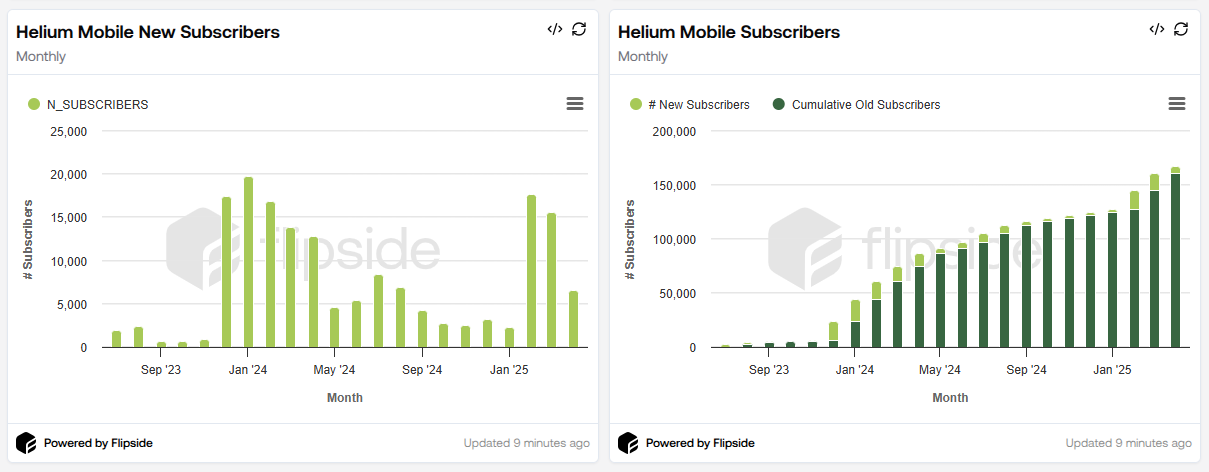 El crecimiento de abonados sigue siendo sólido. En abril de 2025, Helium Mobile contaba con más de 166.700 abonados, un 4% más que en marzo y un 31% más que en enero de 2025. Sólo en febrero de 2025 se registró una afluencia de más de 17.600 nuevos abonados, la mayor incorporación mensual en lo que va de año.
El crecimiento de abonados sigue siendo sólido. En abril de 2025, Helium Mobile contaba con más de 166.700 abonados, un 4% más que en marzo y un 31% más que en enero de 2025. Sólo en febrero de 2025 se registró una afluencia de más de 17.600 nuevos abonados, la mayor incorporación mensual en lo que va de año.
 Paralelamente al crecimiento de abonados, la incorporación de hotspots ha aumentado significativamente. Enero de 2024 marcó un máximo histórico, con más de 3.580 nuevos hotspots incorporados. En el primer trimestre de 2025, la red añadió más de 4.780 nuevos puntos de acceso. Sólo en las dos primeras semanas de abril se añadieron 1.639 nuevos hotspots, lo que refleja una tasa de crecimiento del 12,4%. En la actualidad, la red Helium cuenta con unos 90.000 puntos de acceso.
Paralelamente al crecimiento de abonados, la incorporación de hotspots ha aumentado significativamente. Enero de 2024 marcó un máximo histórico, con más de 3.580 nuevos hotspots incorporados. En el primer trimestre de 2025, la red añadió más de 4.780 nuevos puntos de acceso. Sólo en las dos primeras semanas de abril se añadieron 1.639 nuevos hotspots, lo que refleja una tasa de crecimiento del 12,4%. En la actualidad, la red Helium cuenta con unos 90.000 puntos de acceso.
XNET: Un competidor en alza en Solana
XNET, otro proyecto destacado de DePIN, migró a Solana en agosto de 2024. El principal objetivo de XNET es proporcionar conectividad inalámbrica descentralizada para casos de uso B2B, en particular la descarga de datos de operadores móviles.
XNET incentiva a los operadores para que desplieguen puntos de acceso Wi-Fi especializados, conocidos como "Passpoints", recompensándoles con tokens $XNET en función de la cobertura de la red y el caudal de datos.
XNET incentiva a los operadores para que desplieguen puntos de acceso Wi-Fi especializados, conocidos como "Passpoints".
Comparación entre XNET y Helium: Métricas clave
 Si bien XNET se encuentra significativamente por detrás de Helium en volumen de datos de descarga—19.760 GB frente a los 201.000 GB de Helium’en febrero de 2025—muestra un crecimiento sustancialmente más rápido.
Si bien XNET se encuentra significativamente por detrás de Helium en volumen de datos de descarga—19.760 GB frente a los 201.000 GB de Helium’en febrero de 2025—muestra un crecimiento sustancialmente más rápido.
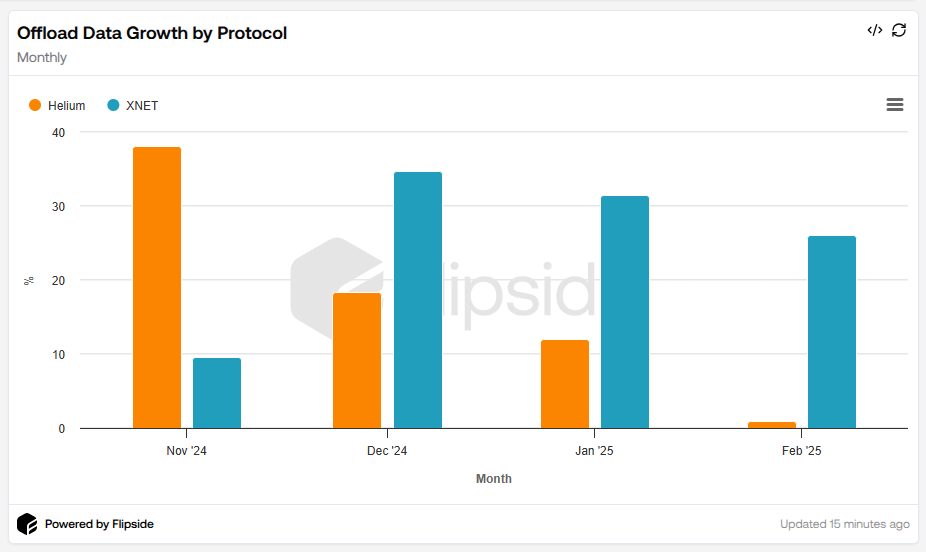 El volumen de datos de descarga de XNET aumentó un 26% intermensual en febrero de 2025, eclipsando el modesto crecimiento del 0,84% de Helium.
El volumen de datos de descarga de XNET aumentó un 26% intermensual en febrero de 2025, eclipsando el modesto crecimiento del 0,84% de Helium.
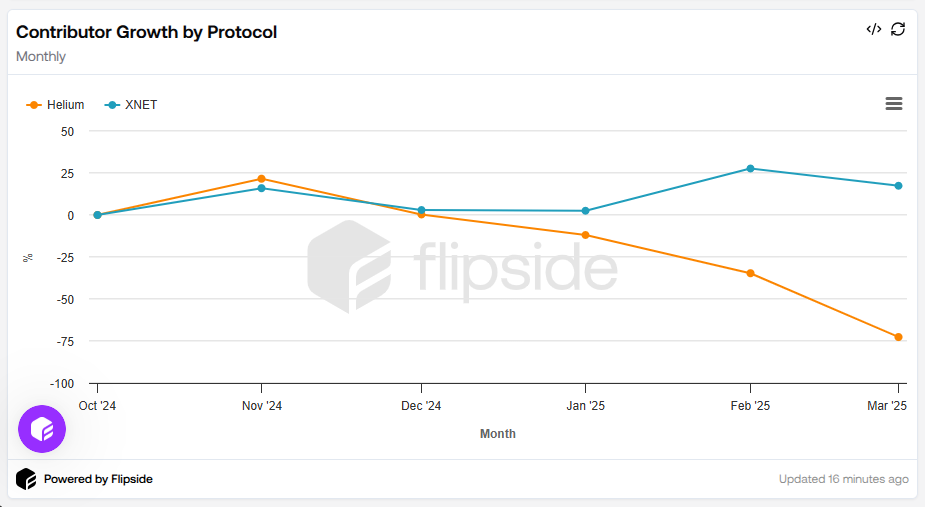 El crecimiento de los contribuidores también favorece a XNET, con incrementos mensuales de entre el 2,5% y el 27%. Por el contrario, Helium se ha enfrentado a un descenso en el número de contribuyentes, incluyendo una caída del 11,8% de diciembre a enero y un fuerte descenso del 72% en marzo de 2025.
El crecimiento de los contribuidores también favorece a XNET, con incrementos mensuales de entre el 2,5% y el 27%. Por el contrario, Helium se ha enfrentado a un descenso en el número de contribuyentes, incluyendo una caída del 11,8% de diciembre a enero y un fuerte descenso del 72% en marzo de 2025.
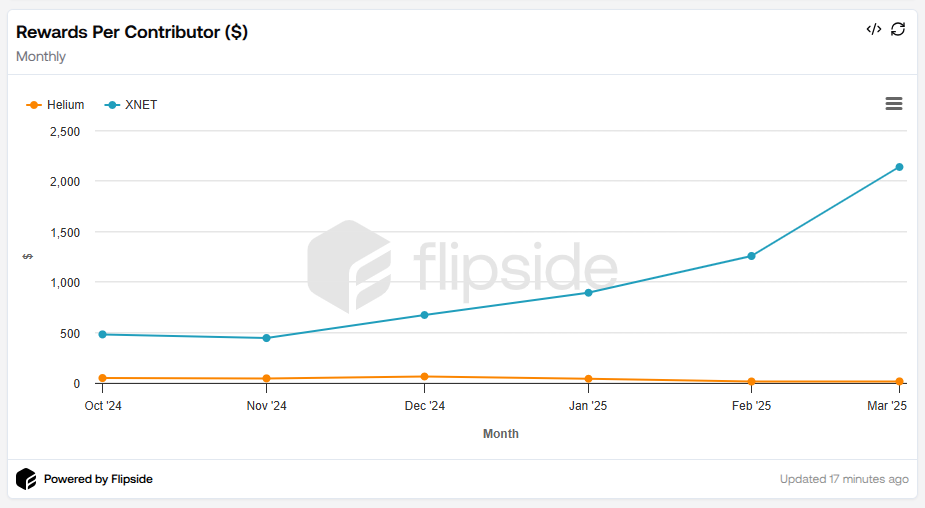 Una de las métricas más convincentes son las Recompensas por contribuyente. Entre octubre de 2024 y marzo de 2025, las recompensas de XNET aumentaron de 482 $ a más de 2.143 $ por contribuyente, un crecimiento notable de 4,4 veces. Mientras tanto, Helium experimentó un marcado descenso, con una caída de las recompensas del 68%, pasando de aproximadamente 49 $ a 15,5 $ por contribuyente en el mismo periodo de tiempo.
Una de las métricas más convincentes son las Recompensas por contribuyente. Entre octubre de 2024 y marzo de 2025, las recompensas de XNET aumentaron de 482 $ a más de 2.143 $ por contribuyente, un crecimiento notable de 4,4 veces. Mientras tanto, Helium experimentó un marcado descenso, con una caída de las recompensas del 68%, pasando de aproximadamente 49 $ a 15,5 $ por contribuyente en el mismo periodo de tiempo.
Porcentajes de recompensas por contribuyente en el mismo periodo de tiempo.
El futuro de DePIN en Solana
Tanto Helium como XNET ejemplifican el potencial transformador de las redes de infraestructuras descentralizadas. Mientras Helium mantiene el dominio con su escala de red establecida, la trayectoria de rápido crecimiento de XNET sugiere una vibrante competencia por delante. A medida que DePIN continúe evolucionando, aprovechando plataformas de blockchain como Solana, el futuro promete importantes oportunidades para la conectividad descentralizada y la innovación en infraestructuras.
Solana es una de las redes de infraestructura descentralizada más importantes del mundo.
Más información sobre SolanaFloor:
¿Posicionará Donald Trump su Memecoin antes del desbloqueo de 336 millones de dólares?
Helio & el Futuro del DePIN: What’s Next for Solana?



